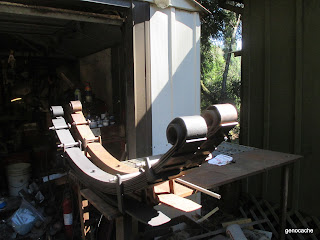Starting off in the cool of the morning I jacked up the back of the 109 and put it on jack stands.
Removed the tyres and supported the outer axle with a jack stand and the spring with a bottle jack.
From here I loosened the spring pins at the frame and shackle and then I removed the nuts holding the U-bolts on slowly. The spring came down until it bound up on the shock plate and then I had to use a hammer to get it to fully release. Then I removed the chassis pin and dropped one end of the spring.
Here you can see the LHD spring next to the old HD springs.
Dragging the spring under the vehicle I connected the chassis pin first and then the shackle pin. I had to slip my floor jack under the spring with the shock plate between them. It was just a matter of jacking up the spring and aligning the brake pipe protection plate and the spring locater pin into the axle housing hole. This went well on the LHD side but the shock expanded on the RHD side to make it harder. On that side I had to use a 2 x 4 to pry the axle forward so it all aligned.
Once the locater was located I had to fit the u-bolts. I decided to reuse the Rocky Mountain u-bolts as I had previously drilled out the shock plate to fit the larger diameter. Somewhere, somehow the u-bolts no longer lined up with the holes. In the pic below you can see that it was about a half a hole out.
Putting them in my vise I could squeeze them down and re-set the width. This took repeated trips because the plate was under the spring and above the jack.
When I did the other side I took the shock plate with me and fit the u-bolts to it. IIRC the finished center to center was 3-3/8".
In the next pic you can see the old spring loosely bolted in place with no weight on it.
Here is a couple of pics of the old RM springs, the shackle bushes totally shot. I can only surmise that somehow I put them in incorrectly.....I don't know, maybe it is because my driveway is slanted and I need to be flat?
At any rate I did one side and then the other, jacked it up and removed the jack stands. When I lowered it to the ground I thought it was never going to stop! I even stopped lowering it and checked to make sure I had all the bolts in. The LHD side spring is flat, well maybe even under flat. Be that as it may I moved the 109 back and forth about 20 feet to settle the springs and then tightened the u-bolts to 58ft-lbs and the pins to 70ft-lbs and the wheel nuts to 80ft-lbs.
The RHD side is not much better;
The left rear from the outside;
Crap I can't even drive it!
Time to bite the bullet and order 1 ton springs.













































































